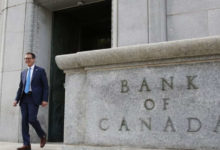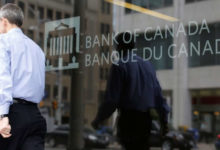Bank of Canada ends QE bond buying program, a sign that higher rates are coming

Canada’s central bank is keeping its benchmark policy interest rate right where it is, but is signalling that higher rates are coming soon.
In its latest policy decision, the Bank of Canada opted Wednesday to hold its benchmark rate steady at 0.25 per cent, the same level it has been throughout the pandemic.
The bank slashed its rate in March 2020 to stimulate the economy by making it as cheap as possible to borrow and invest.
While holding that rate steady, the bank’s statement does make it clear that it’s getting ready to raise that rate sooner rather than later as the economy gets back on to its own two feet and the cost of living is increasing at a faster pace than expected.
“The main forces pushing up prices — higher energy prices and pandemic-related supply bottlenecks — now appear to be stronger and more persistent than expected,” the bank said, adding that it now thinks Canada’s multi-year high inflation rate will stick around for longer than previously thought — into 2022 at least.
Normally, higher than expected inflation is the sort of thing that would compel a central bank to hike its interest rate to cool things down. But the bank isn’t doing that because stimulus is still needed to get out of the pandemic hole that the economy fell into last year.
While the bank makes it clear it’s not ready to raise its benchmark rate yet, it gave a clear signal that it is headed in that direction by winding down its so-called quantitative easing program, one that saw the bank buy up as much as $5 billion worth of government bonds every week to keep lending cheap.
What is QE and how does it work?
Quantitative easing or QE works by having a central bank buy up large amounts of government bonds, which pushes up the price or those bonds since there is a sudden and sustainable surge in demand for them.
That in turn drags down their yield or the rate of interest attached to them, which has the effect of bringing down the cost of all sorts of things linked to government bond yields, including some mortgages and business loans.
Governments around the world implemented QE programs throughout last year as a way to squeeze as much stimulus into the system, even after they slashed their lending rates to basically zero.
As Canada’s economy has slowly improved through 2021, the bank has slowly wound down the number of bonds it was buying under the program, and on Wednesday announced it would come to an end entirely.
That’s a sign that the bank is getting ready to raise rates. Economists think there could be as many as four rate hikes by the end of next year.
“We expect the Bank will raise rates three times next year, taking the overnight rate to 1 per cent by the end of 2022,” economist Sri Thanabalasingam with TD Bank said. “Inflation is heating up, and it would be prudent to remove some monetary stimulus as the economy continues down the road to recovery.”
The Canadian dollar jumped on the news, gaining about two thirds of a cent to trade at 81.35 cents US.








Redes Sociais - Comentários